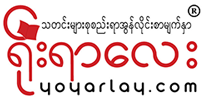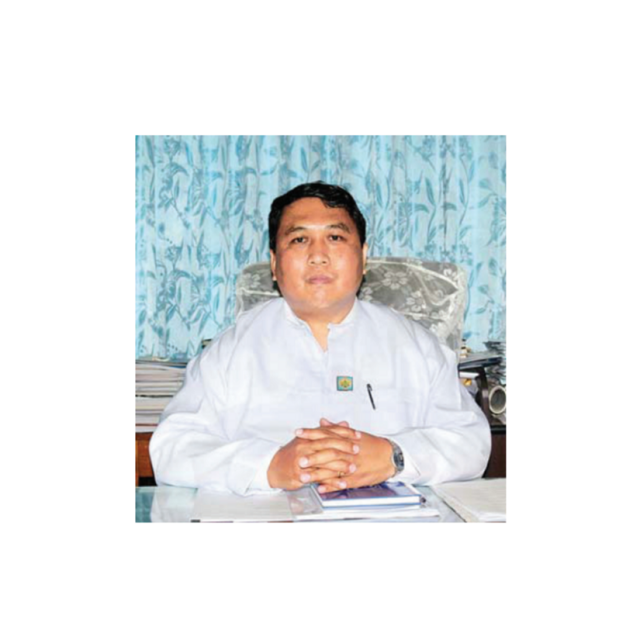Yangonites were worried about the air quality of the city they are living in. In this regard, Yangon (Kaba Aye) Station of Meteorology and Hydrology Department has been issuing the daily air quality of Yangon (PM2.5) it had measured since 6 this February on its Facebook pages. So, a media team of the News and Periodicals Enterprise interviewed Dr. Kyaw Moe Oo, Directior General of Meteorology and Hydrology Department as follows:
Q: Residents of Yangon are worried about the air quality of the city. Your answer please!
A: Our department is recording and releasing the air quality index of Yangon. Yangon City Development Committee (YCDC) and some NGOs are also doing the same job. NGOs mostly measure the air quality at the most crowded times, and release the index. In early this month, an NGO measured the air quality of a place during a crowded period, and released a news report, saying that the air quality of Yangon reached the danger level. The public had noticed the announcement. The organization concerned even said as if the air quality was worse than that of Bangkok or Beijing. In reality the air quality of the said two mega cities is much worse than Yangon. So experts had already responded to the NGO’s announcement.
In the past we sent the air quality report to East Asia Network Center of Acid Deposition (EANED) biannually and annually. The World Meteorological Organization compiled reports from different countries to create a country-wise air quality index. Myanmar was not included in the list of nations with a high degree of air pollution. We were only at the middle stage. We were also recording the air quality of the city in the past, but we never released the results. Now, we have been issuing the authentic index since 6 this month to alleviate public worries.
Mainly there are two air quality recording methods. The first one is the method of measuring in a specific period. But this method can only state the result of an air quality measurement done during a particular crowded period in the index. We will have to measure the air quality the whole 24 hours. The process goes on the whole day, the whole month and the whole year. As the people were worried about the air pollution, we have been issuing the index since 6 this month. The index proves that air pollution is not at the red level as it is between 50 and 100. If it exceeds 100, it may be hazardous to senior people, children and people with respiratory problems.
Q: Please elaborate on your department’s air quality monitoring process in Yangon.
A: We haven’t had the township-wise measuring process. The equipment at Kaba Aye Station is recording the air quality. We understand that we may have better result if we can install such equipment in every township. We are now recording the air quality of the area within the 50 kilometre radius.
We have programs to development our air quality detection system. The programs include the detection of air pollution with advanced mobile machines next year. In Mandalay, the Environmental Conservation Department (ECD) is recording the air quality with the Japanese-aided machine. First, it was donated for our department. But as the work concerns more with the ECD we transferred the machine to it. But they are sending the results to us. Next year, we will install a similar machine in Nay Pyi Taw. We will extend our work every financial year.
Q: Some are questioning whether the monitoring process should be done in every township, as the results vary according to the place where the monitoring takes place. Can you please explain this?
A: We have already advised our staff to inform the public about the air quality. We are issuing the results on our website and Facebook pages. We understand that monitoring should be conducted in every township. In the past a weather station in each 50-kilometre perimeter was enough, but climate change has made the matter more confusing. Developed countries are erecting a weather station in every three or five kilometer perimeter. The results can be varied from time to time as air quality normally drops during the rush hours.
A township where more of cars roll and more air-conditioners are switched on will have more carbon emissions in the air. As there is difference between towns in the volume of carbon footprint, township-wise recording is required.
But we cannot draw a conclusion from a result of a specific period. Ex cessive emission of carbon may cause climate change. So, we are trying to reduce the carbon footprint. Road Transport Administration Department is now even checking the carbon footprint of a car. The government has been prioritizing the issue of air quality. Myanmar is a signatory to the Paris Climate Agreement. So people should use public transport rather than private cars. Both the Individual participation and the use of renewable energy are important in alleviating the carbon footprint.
Q: Some of the border areas are facing air pollution. Are there any plans to address the problem?
A: We haven’t had such plans yet. But we are monitoring the acid rain fall in those areas. The ASEAN is implementing a program to look into the matter. During the previous year, Myanmar and Thailand exchanged information about the haze in the border area. In Tachilek, people had to pour water to halt the haze.
Q: Your department has any plans to announce the impacts of the climate change in time?
A: We now have an ongoing JICA-aided program. JICA or the Japan International Cooperation Agency has provided automatic weather forecasting equipment, radars and satellite-aided cloud detectors. Korean Meteorological Agency also presented automatic weather forecasting equipment for us. The government is also installing more automatic weather forecasting equipment under the Immediate Response Fund, and distributing weather information in real time.
In the past, we could issue the weather report only once a day. But now, we are releasing weather report five times –at 7 am, noon, 2 pm, 4 pm and 7pm — a day, and issuing special weather reports as and when necessary.
As we are receiving public response for our weather reports, we are happy to know that public interest in weather is rising. Public interest in weather was low till before the occurrence of Nargis storm in 2008. When weather report program appeared on TV, most of the viewers switched to other channel. But now, more and more people are interested in it. In the developed countries, people usually watch the TV weather news as soon as they rise from the bed, and they dress in accord with the weather condition.
But, concerning the matter, we are still behind some neighbours which also had low public interest in the weather in the past. But public awareness of the weather has gradually risen since 2008 thanks to the government efforts and international aids.
Q: Any more information for the public?
A: Climate change is affecting the whole world. So, it’s important to adapt to the changing weather conditions. We should slow down or even halt the climate change through conservation and alternation undertakings. For example, we should introduce crops strains that can withstand the severe weather conditions, and conduct broader awareness programs. We need broader knowledge of the natural disasters triggered by the climate change. But the most important thing is to adapt ourselves to the changes.
Interviewer: Shin Min
Photo: Hein Min Soe, Phoe Khwar
Ref: The Global New Light of Myanmar

